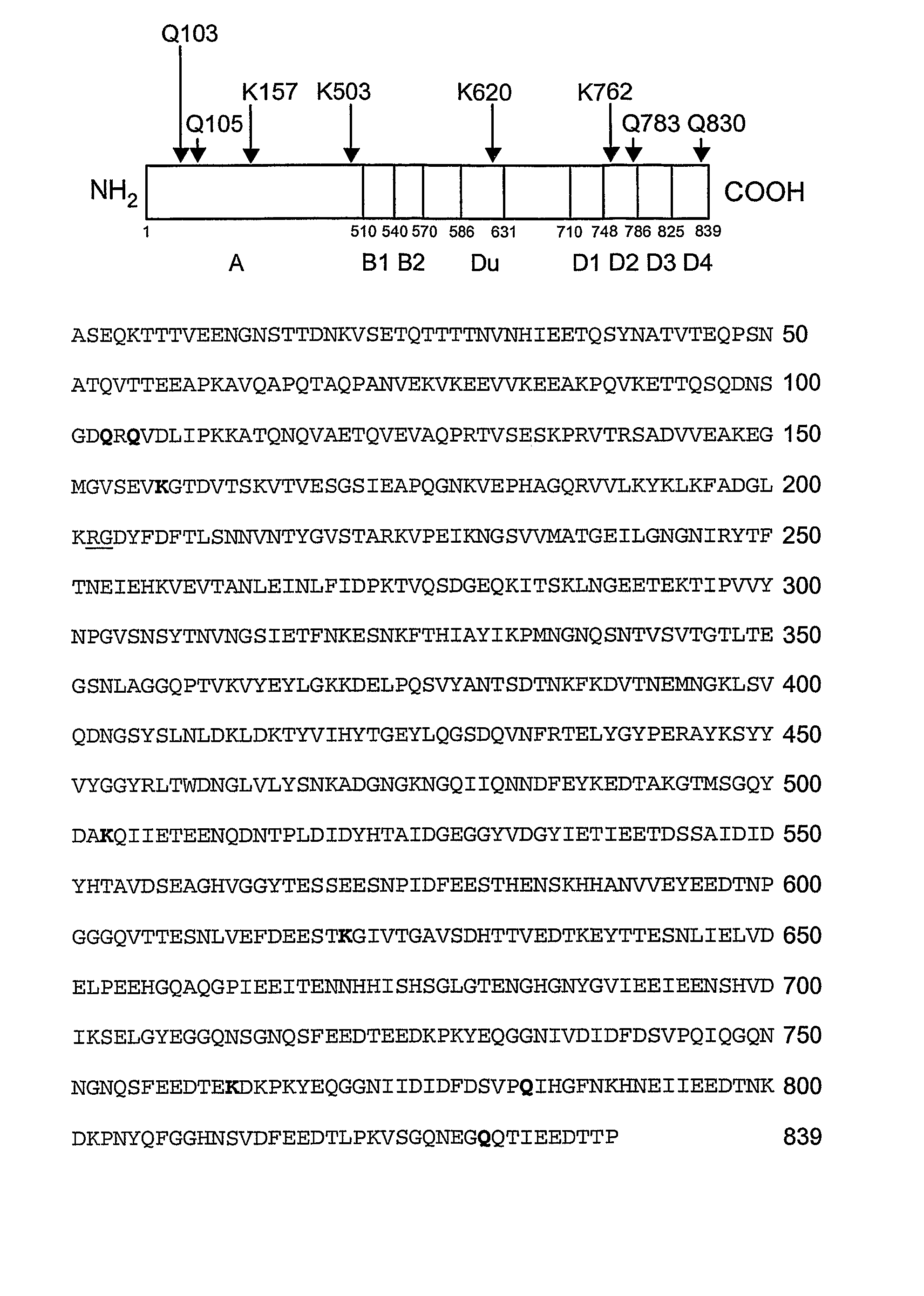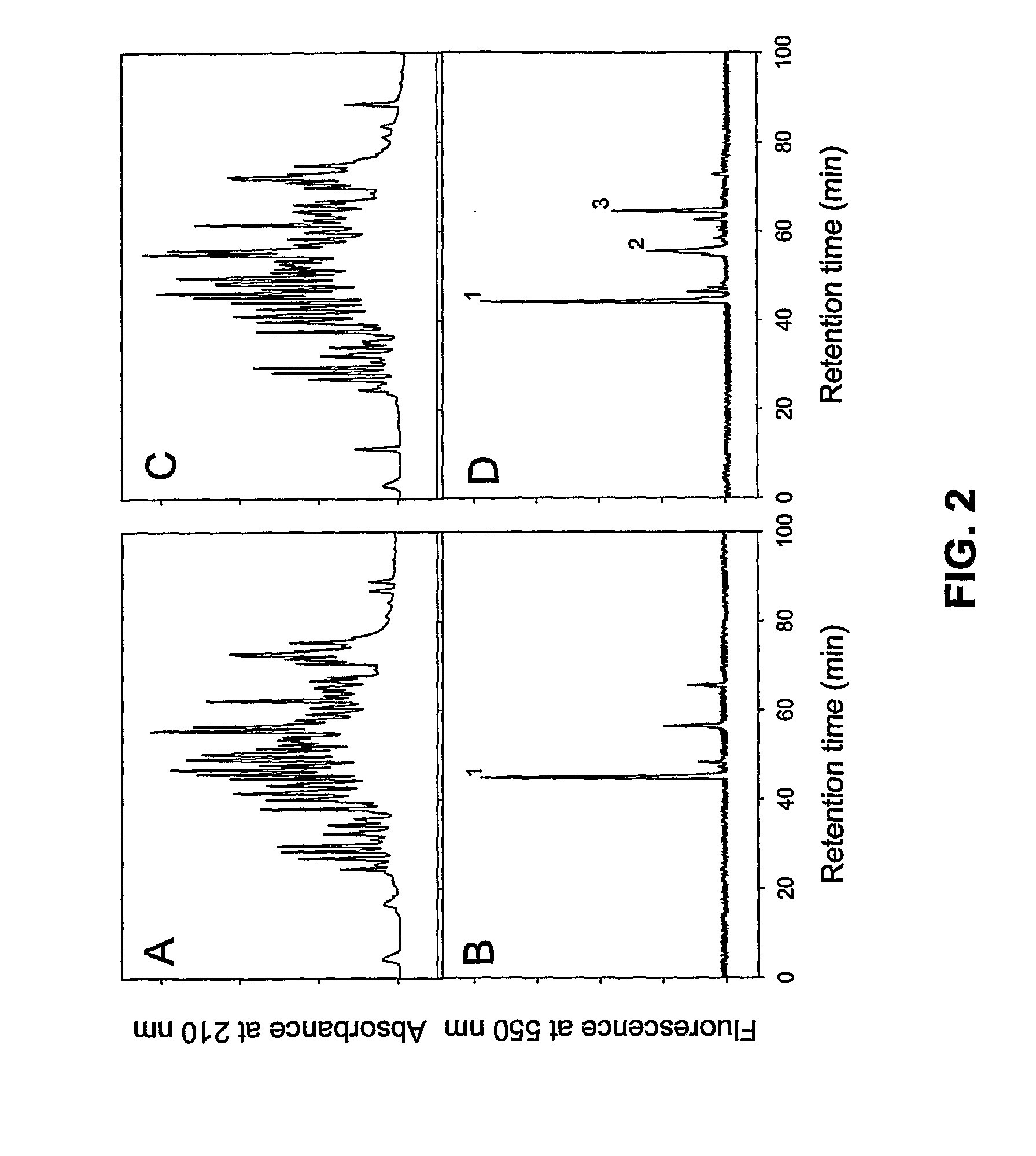Altered Fibronectin-Binding Protein of Staphylococcus Aureus
a staphylococcus, fibronectin-binding technology, applied in the direction of antibacterial agents, immunological disorders, antibody medical ingredients, etc., can solve the problems of lack of inhibitory/neutralizing activity of antibodies, inability to inhibit binding,
- Summary
- Abstract
- Description
- Claims
- Application Information
AI Technical Summary
Benefits of technology
Problems solved by technology
Method used
Image
Examples
example 1
Factor XIIIa-Directed Incorporation of Dansylcadaverine and Dansyl-PGGQQIV into rFnbA and Fragmentation of Probe-decorated Protein by Thrombin
[0124] It has been reported that fibronectin-binding protein A from S. aureus strain ATCC49525 serves as a bifunctional substrate for coagulation Factor XIIIa that contains both reactive Gln and Lys residues (Matsuka et al. 2003). To assess the location of reactive Gln and Lys residues within FnbA, amine donor (dansylcadaverine) or amine acceptor (dansyl-PGGQQIV) fluorescent probes were incorporated into rFnbA by the catalytic action of Factor XIIIa. Reactions were carried out for 4 or 18 hours, followed by the removal of unreacted probes and the fragmentation of fluorescent-tracer-labeled rFnbA by thrombin. The existence of a single Arg202-Gly203 peptide bond within FnbA that is sensitive to thrombin attack allows the generation of two fragments representing the N- and C-terminal portions of rFnbA with theoretically estimated molecular masse...
example 2
Identification of the rFnbA Glutamine Acceptor Sites Involved in Factor XIIIa Cross-Linking Reactions
[0126] To identify the specific reactive Gln residue(s) within rFnbA, the latter was incubated for 4 and 18 hours in the presence of Factor XIIIa and a molar excess of the fluorescent probe dansylcadaverine. Following the dansylcadaverine labeling reaction, the modified rFnbA preparations were washed from the unreacted probe and then digested with trypsin. HPLC separation of the tryptic peptides produced after a 4 hour Factor XIIIa-catalyzed incorporation of dansylcadaverine into rFnbA revealed a complex profile at 210 nm (FIG. 2A). In contrast, only one major peak with retention time of approximately 44 min was detected in the same sample upon monitoring of fluorescence at 550 nm (FIG. 2B, peak 1). Extension of the incubation time of rFnbA in the presence of Factor XIIIa and dansylcadaverine from 4 hours to 18 hours and subsequent digestion with trypsin did not have an impact eithe...
example 3
Identification of the rFnbA Lysine Donor Sites Involved in Factor XIIIa Cross-Linking Reactions
[0129] The Factor XIIIa-mediated titration of Lys side chains of rFnbA was performed using the dansyl-PGGQQIV peptide patterned on the N-terminal sequence of fibronectin. The rFnbA was incubated for 4 hours in the presence of Factor XIIIa and dansyl-PGGQQIV probe and then digested with Glu-C proteinase. The HPLC separation of Glu-C proteinase-generated peptides again revealed multiple peaks detected at 210 nm and only a few fluorescent peaks, eluting in the range of approximately 60 minutes (FIGS. 4A and B). However, with the exception of the peak marked by an asterisk (FIG. 4B), the degree of labeling and consequently the level of purity of the probe-modified peptides were not sufficient for required sequence analysis. To improve the recovery of dansyl-PGGQQIV-modified peptides, the rFnbA was incubated with Factor XIIIa and dansyl-PGGQQIV probe for 18 hours and digested with Glu-C protei...
PUM
| Property | Measurement | Unit |
|---|---|---|
| pH | aaaaa | aaaaa |
| pH | aaaaa | aaaaa |
| pH | aaaaa | aaaaa |
Abstract
Description
Claims
Application Information
 Login to View More
Login to View More - R&D
- Intellectual Property
- Life Sciences
- Materials
- Tech Scout
- Unparalleled Data Quality
- Higher Quality Content
- 60% Fewer Hallucinations
Browse by: Latest US Patents, China's latest patents, Technical Efficacy Thesaurus, Application Domain, Technology Topic, Popular Technical Reports.
© 2025 PatSnap. All rights reserved.Legal|Privacy policy|Modern Slavery Act Transparency Statement|Sitemap|About US| Contact US: help@patsnap.com



